Custard Experiments
By Mike on Sunday, July 8, 2012, 21:20 - Permalink
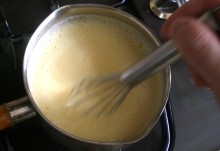 I love custard. Egg custard is great, but I also like conflour-based custard - especially the skin that forms on top when it cools.
I love custard. Egg custard is great, but I also like conflour-based custard - especially the skin that forms on top when it cools.
But there's never enough skin - so I set about trying to make more.
First Thoughts
That I love custard skin is a matter of record amongst friends and family, I've kept saying that one day, I was going to make a jug of custard and pour it on a tray, so as to maximise the surface to be turned to skin.

So that was the first thing to try - I made a pint of custard and poured half of it, hot, onto a clean plastic tray.
To my great disappointment, it cooled without forming any skin at all, whereas the half pint I left in the jug formed a thick, normal skin.
What Happened?
Formation of custard skin appears to be a process of drying - the custard in the jug retained its heat for longer, driving off moisture from the top surface, drying it out to form skin, whereas the custard poured onto the tray cooled too fast for this to happen.
So... obviously I need to try to spread it out, but keep it warm - time for another round of experiments...
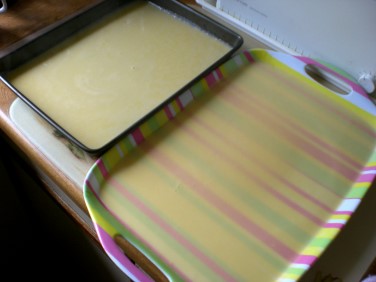 Another pint of custard, split into two trays, each to be given a different treatment.
Another pint of custard, split into two trays, each to be given a different treatment.
The metal one will go into a very low oven for up to half an hour, with the door being opened every five minutes or so to release steam and thus assist the custard in drying out.
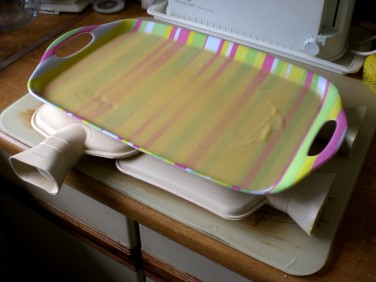 The custard on the plastic tray will be kept warm by balancing the tray on top of hot water bottles filled with boiling water.
The custard on the plastic tray will be kept warm by balancing the tray on top of hot water bottles filled with boiling water.
After half an hour of anticipation and waiting, let's take a look at the results...
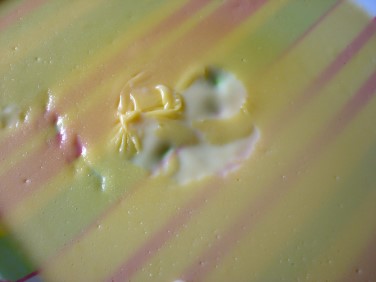 The custard on the plastic tray had formed a skin this time, but it was a pretty pale, feeble one.
The custard on the plastic tray had formed a skin this time, but it was a pretty pale, feeble one.
Not really a success at all.
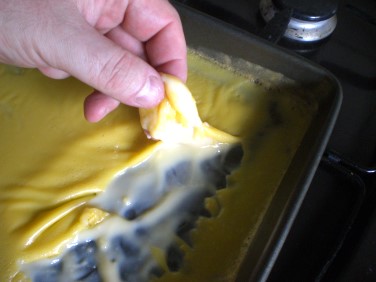 The tray that went in the oven was better - having formed a nice deep yellow skin with a firm, dryish rubbery texture.
The tray that went in the oven was better - having formed a nice deep yellow skin with a firm, dryish rubbery texture.
Pretty good, however, it was still quite a bit thinner than the skin I'm used to finding on top of a jug of hot custard - I think in this case, it may have dried too quickly, creating a thin seal on the top layer, preventing further evaporation.
What Now?
Clearly more experimentation is required - maybe starting with a thicker mixture, maybe forcing evaporation by fanning air across the surface...
I also need to try this with a proper custard made with eggs and cream.
Custard
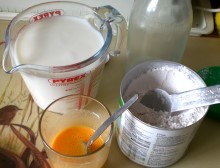 These experiments were performed with custard made from 'Custard Powder' - this is just cornflour (cornstarch), vanilla and yellow colouring - made up with milk and sugar, then heated to thicken.
These experiments were performed with custard made from 'Custard Powder' - this is just cornflour (cornstarch), vanilla and yellow colouring - made up with milk and sugar, then heated to thicken.
 It was formulated by Alfred Bird in 1837, for his wife, who was allergic to eggs, and the leading brand for this product still bears his name. It's really just yellow-coloured vanilla-flavoured blancmange.
It was formulated by Alfred Bird in 1837, for his wife, who was allergic to eggs, and the leading brand for this product still bears his name. It's really just yellow-coloured vanilla-flavoured blancmange.
Liking The Skin
The skin on custard is something that polarises opinion quite violently - I love it - I know others that love it, or find it sickening, but I don't know anyone whose opinion is lukewarm on the subject.
For me, it's just consistent with a lot of other things I like - the crust on bread, the crispy end slice on a roast, chicken skin, pork crackling, the rind on many kinds of cheese - turns out that the outside of things is very often the interesting bit. Beauty is skin deep, literally.
